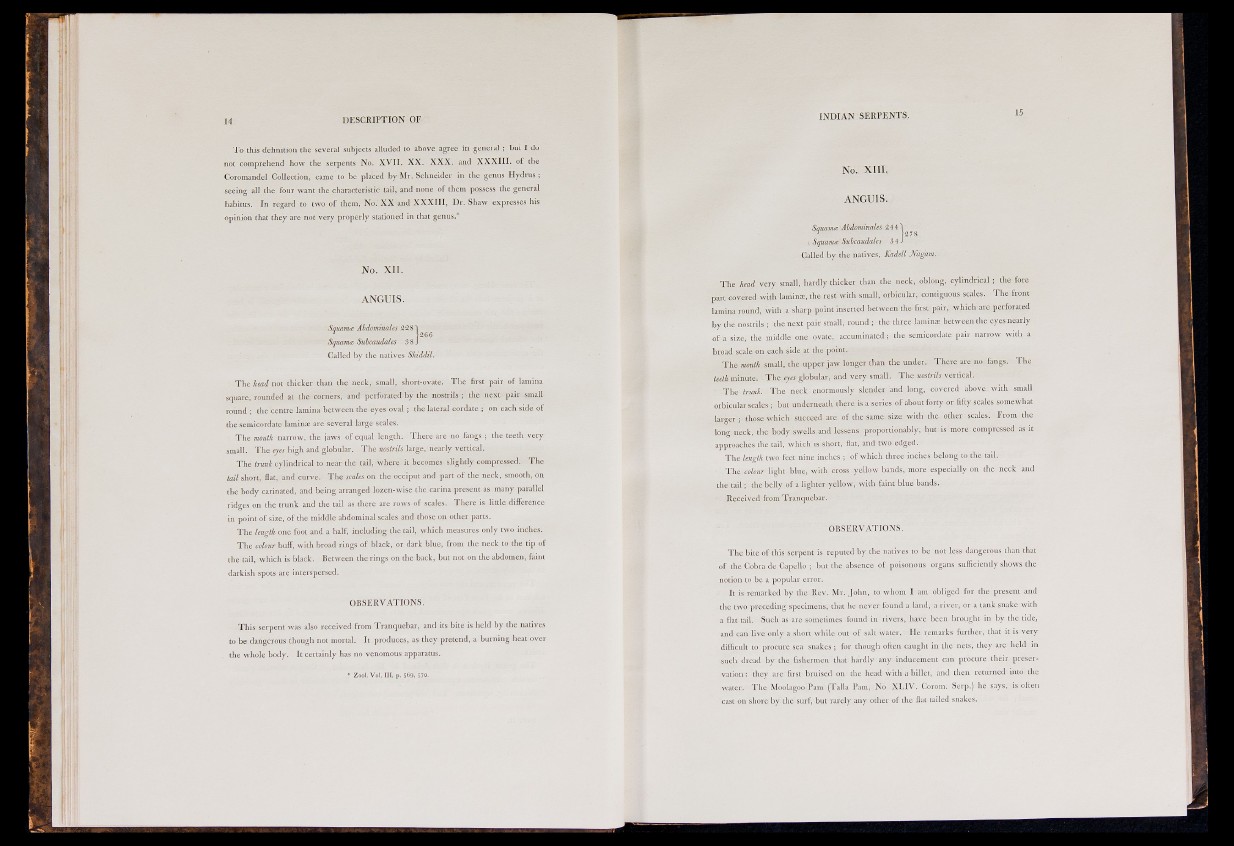
H DE S C R I P T ION OF
To this definition tlie several subjects alluded to above agree in general ; but I do
not comprehend how the serpents No. XVII. XX. XXX. and XXXIII. of the
Coromandel Collection, came to be placed by Mr. Schneider in the genus Hydrus ;
seeing all the four want the characteristic tail, and none of them possess the general
habitus. In regard to two of them, No. XX and XXXI I I , Dr. Shaw expresses his
opinion that they are not very properly stationed in that genus.*
N o . XII.
A N G U I S .
Squama Abdominales 228
Squamce Siibcaudales 3 8 .
Called by the natives Shiddil.
The head not thicker than the neck, small, short-ovate. The first pair of lamina
square, rounded at the corners, and perforated by the nostrils ; the next pair small
round ; the centre lamina between the eyes oval ; the lateral cordate ; on each side of
the semicordate laminae are several large scales.
The mouth narrow, the jaws of equal length. Tliere are no fangs ; the teeth very
small. The eyes high and globular. The nostrils large, nearly vertical.
The trunk cylindrical to near the tail, where it becomes slightly compressed. The
tail short, flat, and curve. The scales on the occiput and part of the neck, smootli, on
the body carinated, and being arranged lozen-wise the carina present as many parallel
ridges on the trunk and the tail as there are rows of scales. There is little difference
in point of size, of the middle abdominal scales and those on other parts.
The length one foot and a half, including the tail, which measures only two inches.
The colour bulF, with broad rings of black, or dark blue, from the neck to the tip of
the tail, which is black. Between the rings on the back, but not on the abdomen, faint
darkish spots are interspersed.
OBSERVATIONS.
This serpent was also received from Tranquebar, and its bite is held by the natives
to be dangerous though not mortal. It produces, as they pretend, a burning lieat over
the whole body. It certainly has no venomous apparatus.
• Zool. Vol. III. p. 569, 570.
I N D I A N SERPENTS.
No. XIII.
ANGUIS.
Squama Abdominales 2441 ^ ^
, Squamie Suhcaudales 3 4 J
Called by the natives, Kadell A''agam.
The head very small, hardly thicker than the neck, oblong, cylindrical ; the fore
part covered with lamins, the rest with small, orbicular, contiguous scales. The front
lamina round, with a sharp point inserted between the first pair, which are perforated
by the nostrils ; the next pair small, round ; the three lamins between the eyes nearly
of a size, the middle one ovate, accuminated ; the semicordate pair narrow with a
broad scale on each side at the point.
The mouth small, the upper jaw longer tlian the under. There are no fangs. The
teeth minute. The eyes globular, and very small. The nostrils vertical.
The trimh. The neck enormously slender and long, covered above with small
orbicular scales ; but underneath there is a series of about forty or fifty scales somewhat
larger ; those which succeed are of the same size with the other scales. From the
long neck, the body swells and lessens proportionably, but is more compressed as it
approaches the tail, which is short, fiat, and two edged.
The length two feet nine inches ; of which three inches belong to the tail.
The colour light blue, with cross yellow bands, more especially on the neck and
the tail; the belly of a lighter yellow, with faint blue bands.
Received from Tranquebar.
OBSERVATIONS.
The bite of this serpent is reputed by the natives to be not less dangerous than that
of the Cobra dc Capello ; but the absence of poisonous organs sulficiently shows the
notion to be a popular error.
It is remarked by the Rev. Mr. John, to whom I am obliged for the present and
the two preceding specimens, that he never found a land, a river, or a tank snake with
a flat tail. Such as are sometimes found in rivers, have been brought in by the tide,
and can live only a short while out of salt water. He remarks further, that it is very
diilicult to procure sea snakes ; for though often caught in the nets, they are held in
such dread by the fishermen that hardly any inducement can procure their preservation
; they are first bruised on the head with a billet, and then returned into the
water. The Moolagoo Pam (Talla Pam, No XLIV. Corom. Serp.) he says, is often
cast on shore by the surf, but rarely any other of the flat tailed snakes.